2016 NISSAN NV PASSENGER VAN recommended oil
[x] Cancel search: recommended oilPage 342 of 380
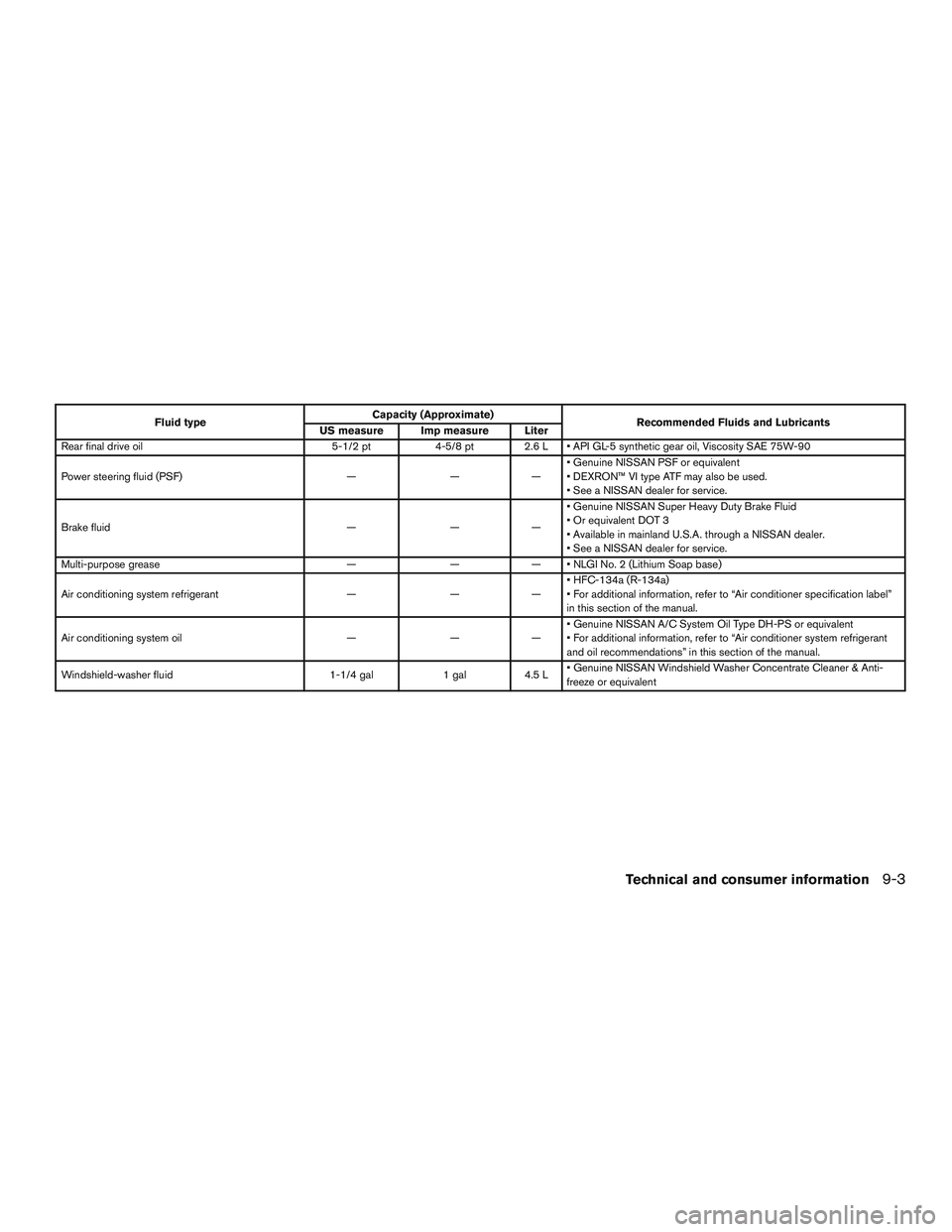
Fluid typeCapacity (Approximate)
Recommended Fluids and Lubricants
US measure Imp measure Liter
Rear final drive oil 5-1/2 pt 4-5/8 pt 2.6 L • API GL-5 synthetic gear oil, Viscosity SAE 75W-90
Power steering fluid (PSF) — — — • Genuine NISSAN PSF or equivalent
• DEXRON™ VI type ATF may also be used.
• See a NISSAN dealer for service.
Brake fluid — — — • Genuine NISSAN Super Heavy Duty Brake Fluid
• Or equivalent DOT 3
• Available in mainland U.S.A. through a NISSAN dealer.
• See a NISSAN dealer for service.
Multi-purpose grease ——— • NLGI No. 2 (Lithium Soap base)
Air conditioning system refrigerant ———• HFC-134a (R-134a)
• For additional information, refer to “Air conditioner specification label”
in this section of the manual.
Air conditioning system oil ———• Genuine NISSAN A/C System Oil Type DH-PS or equivalent
• For additional information, refer to “Air conditioner system refrigerant
and oil recommendations” in this section of the manual.
Windshield-washer fluid 1-1/4 gal1 gal4.5 L• Genuine NISSAN Windshield Washer Concentrate Cleaner & Anti-
freeze or equivalent
Technical and consumer information9-3
Page 345 of 380
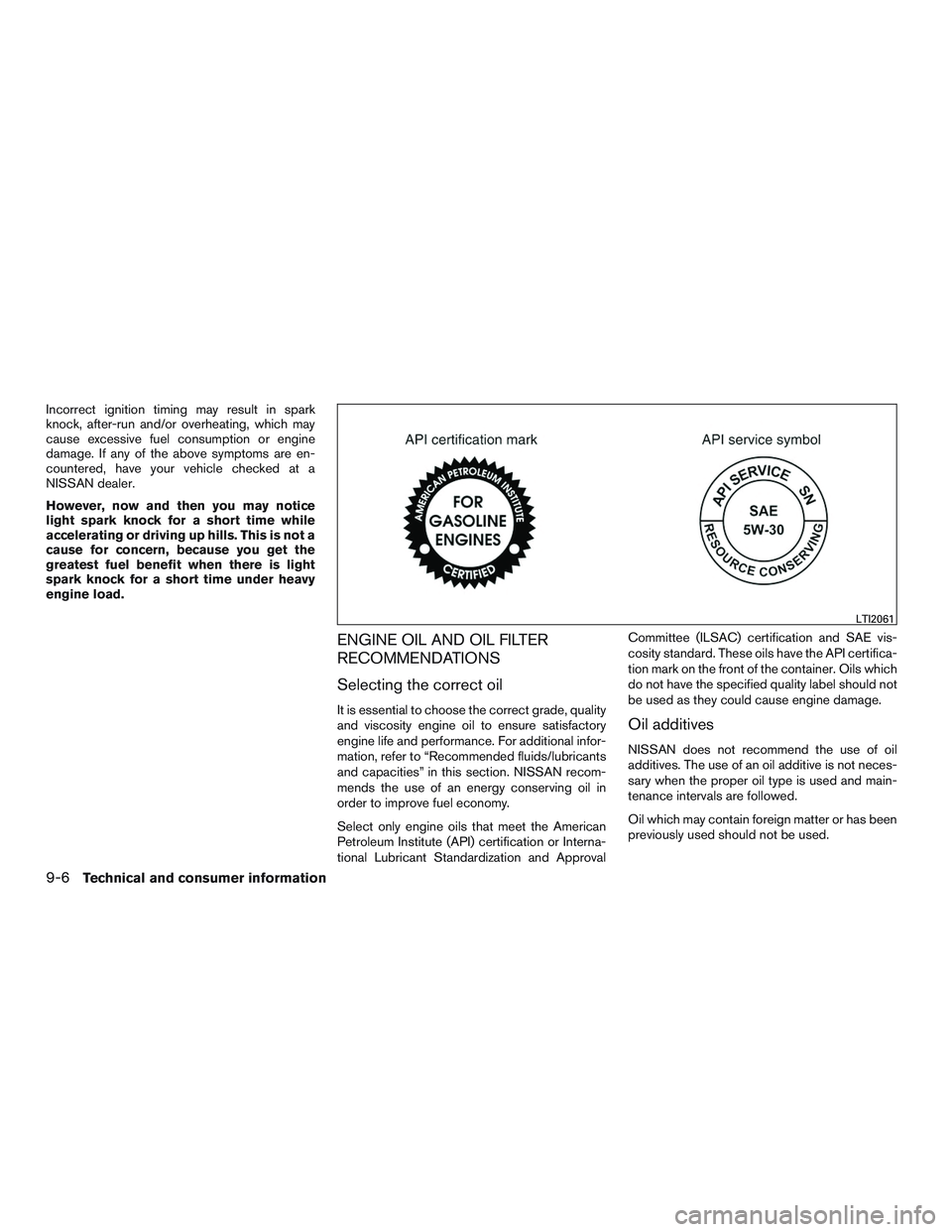
Incorrect ignition timing may result in spark
knock, after-run and/or overheating, which may
cause excessive fuel consumption or engine
damage. If any of the above symptoms are en-
countered, have your vehicle checked at a
NISSAN dealer.
However, now and then you may notice
light spark knock for a short time while
accelerating or driving up hills. This is not a
cause for concern, because you get the
greatest fuel benefit when there is light
spark knock for a short time under heavy
engine load.
ENGINE OIL AND OIL FILTER
RECOMMENDATIONS
Selecting the correct oil
It is essential to choose the correct grade, quality
and viscosity engine oil to ensure satisfactory
engine life and performance. For additional infor-
mation, refer to “Recommended fluids/lubricants
and capacities” in this section. NISSAN recom-
mends the use of an energy conserving oil in
order to improve fuel economy.
Select only engine oils that meet the American
Petroleum Institute (API) certification or Interna-
tional Lubricant Standardization and ApprovalCommittee (ILSAC) certification and SAE vis-
cosity standard. These oils have the API certifica-
tion mark on the front of the container. Oils which
do not have the specified quality label should not
be used as they could cause engine damage.Oil additives
NISSAN does not recommend the use of oil
additives. The use of an oil additive is not neces-
sary when the proper oil type is used and main-
tenance intervals are followed.
Oil which may contain foreign matter or has been
previously used should not be used.
LTI2061
9-6Technical and consumer information
Page 346 of 380
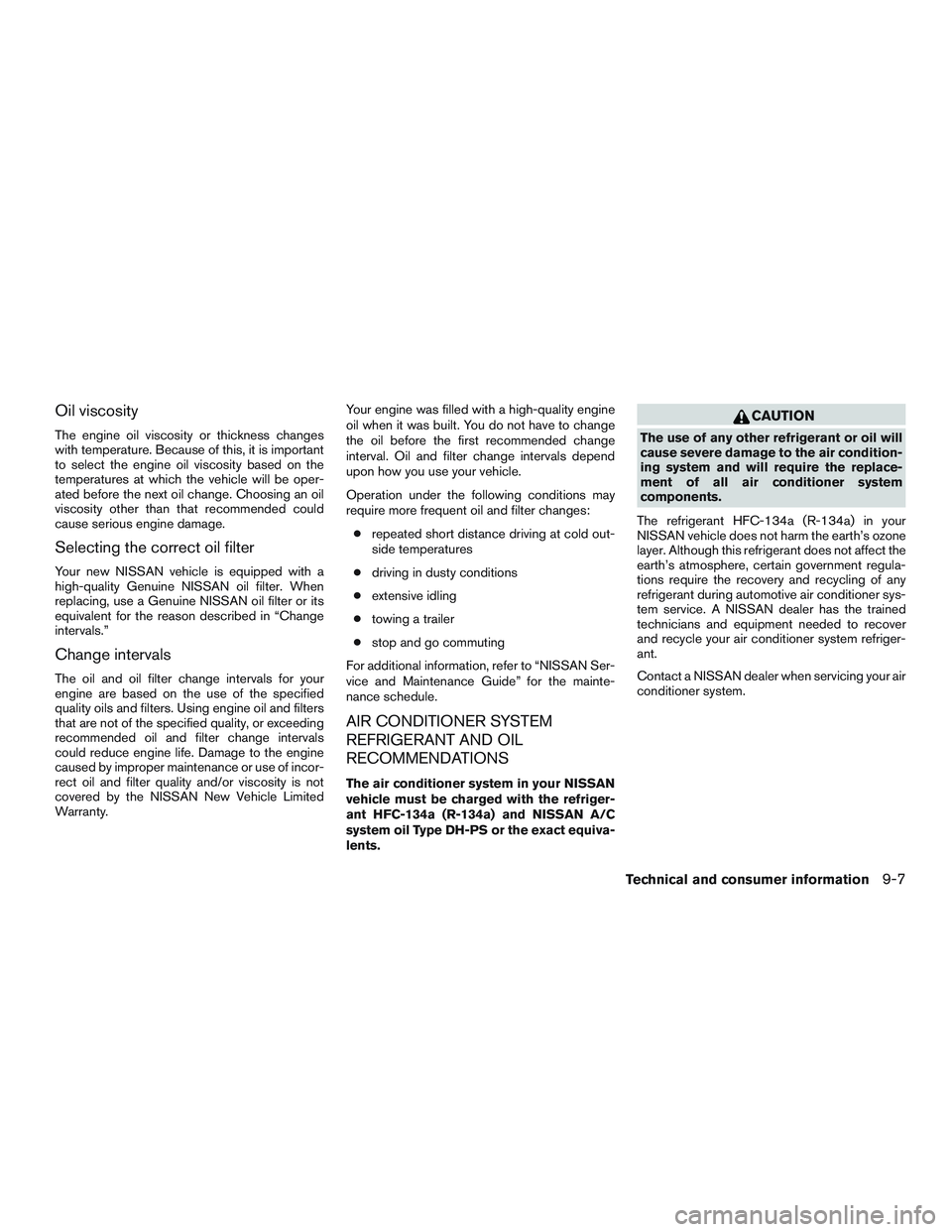
Oil viscosity
The engine oil viscosity or thickness changes
with temperature. Because of this, it is important
to select the engine oil viscosity based on the
temperatures at which the vehicle will be oper-
ated before the next oil change. Choosing an oil
viscosity other than that recommended could
cause serious engine damage.
Selecting the correct oil filter
Your new NISSAN vehicle is equipped with a
high-quality Genuine NISSAN oil filter. When
replacing, use a Genuine NISSAN oil filter or its
equivalent for the reason described in “Change
intervals.”
Change intervals
The oil and oil filter change intervals for your
engine are based on the use of the specified
quality oils and filters. Using engine oil and filters
that are not of the specified quality, or exceeding
recommended oil and filter change intervals
could reduce engine life. Damage to the engine
caused by improper maintenance or use of incor-
rect oil and filter quality and/or viscosity is not
covered by the NISSAN New Vehicle Limited
Warranty.Your engine was filled with a high-quality engine
oil when it was built. You do not have to change
the oil before the first recommended change
interval. Oil and filter change intervals depend
upon how you use your vehicle.
Operation under the following conditions may
require more frequent oil and filter changes:
● repeated short distance driving at cold out-
side temperatures
● driving in dusty conditions
● extensive idling
● towing a trailer
● stop and go commuting
For additional information, refer to “NISSAN Ser-
vice and Maintenance Guide” for the mainte-
nance schedule.
AIR CONDITIONER SYSTEM
REFRIGERANT AND OIL
RECOMMENDATIONS
The air conditioner system in your NISSAN
vehicle must be charged with the refriger-
ant HFC-134a (R-134a) and NISSAN A/C
system oil Type DH-PS or the exact equiva-
lents.
CAUTION
The use of any other refrigerant or oil will
cause severe damage to the air condition-
ing system and will require the replace-
ment of all air conditioner system
components.
The refrigerant HFC-134a (R-134a) in your
NISSAN vehicle does not harm the earth’s ozone
layer. Although this refrigerant does not affect the
earth’s atmosphere, certain government regula-
tions require the recovery and recycling of any
refrigerant during automotive air conditioner sys-
tem service. A NISSAN dealer has the trained
technicians and equipment needed to recover
and recycle your air conditioner system refriger-
ant.
Contact a NISSAN dealer when servicing your air
conditioner system.
Technical and consumer information9-7
Page 366 of 380
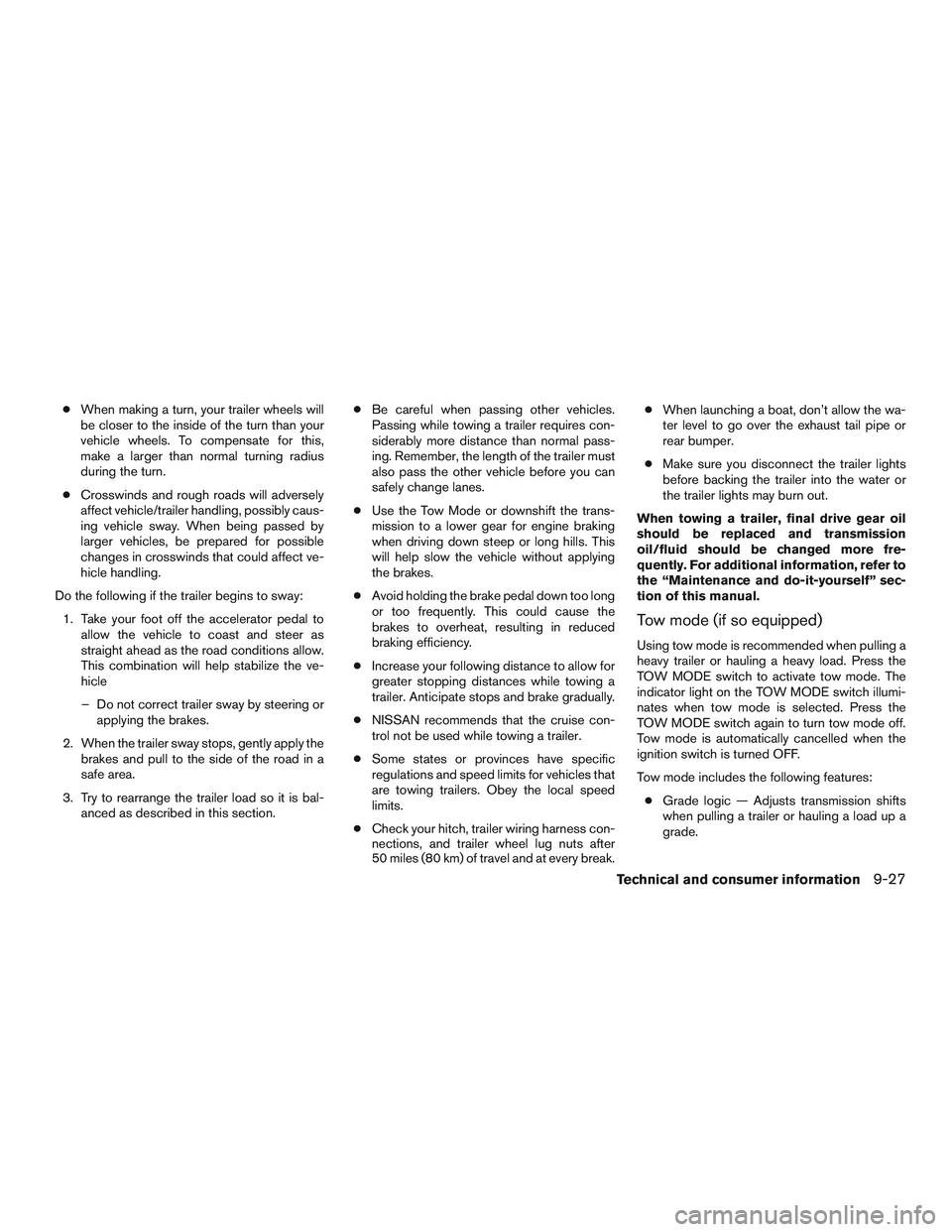
●When making a turn, your trailer wheels will
be closer to the inside of the turn than your
vehicle wheels. To compensate for this,
make a larger than normal turning radius
during the turn.
● Crosswinds and rough roads will adversely
affect vehicle/trailer handling, possibly caus-
ing vehicle sway. When being passed by
larger vehicles, be prepared for possible
changes in crosswinds that could affect ve-
hicle handling.
Do the following if the trailer begins to sway: 1. Take your foot off the accelerator pedal to allow the vehicle to coast and steer as
straight ahead as the road conditions allow.
This combination will help stabilize the ve-
hicle
– Do not correct trailer sway by steering or applying the brakes.
2. When the trailer sway stops, gently apply the brakes and pull to the side of the road in a
safe area.
3. Try to rearrange the trailer load so it is bal- anced as described in this section. ●
Be careful when passing other vehicles.
Passing while towing a trailer requires con-
siderably more distance than normal pass-
ing. Remember, the length of the trailer must
also pass the other vehicle before you can
safely change lanes.
● Use the Tow Mode or downshift the trans-
mission to a lower gear for engine braking
when driving down steep or long hills. This
will help slow the vehicle without applying
the brakes.
● Avoid holding the brake pedal down too long
or too frequently. This could cause the
brakes to overheat, resulting in reduced
braking efficiency.
● Increase your following distance to allow for
greater stopping distances while towing a
trailer. Anticipate stops and brake gradually.
● NISSAN recommends that the cruise con-
trol not be used while towing a trailer.
● Some states or provinces have specific
regulations and speed limits for vehicles that
are towing trailers. Obey the local speed
limits.
● Check your hitch, trailer wiring harness con-
nections, and trailer wheel lug nuts after
50 miles (80 km) of travel and at every break. ●
When launching a boat, don’t allow the wa-
ter level to go over the exhaust tail pipe or
rear bumper.
● Make sure you disconnect the trailer lights
before backing the trailer into the water or
the trailer lights may burn out.
When towing a trailer, final drive gear oil
should be replaced and transmission
oil/fluid should be changed more fre-
quently. For additional information, refer to
the “Maintenance and do-it-yourself” sec-
tion of this manual.
Tow mode (if so equipped)
Using tow mode is recommended when pulling a
heavy trailer or hauling a heavy load. Press the
TOW MODE switch to activate tow mode. The
indicator light on the TOW MODE switch illumi-
nates when tow mode is selected. Press the
TOW MODE switch again to turn tow mode off.
Tow mode is automatically cancelled when the
ignition switch is turned OFF.
Tow mode includes the following features: ● Grade logic — Adjusts transmission shifts
when pulling a trailer or hauling a load up a
grade.
Technical and consumer information9-27
Page 367 of 380
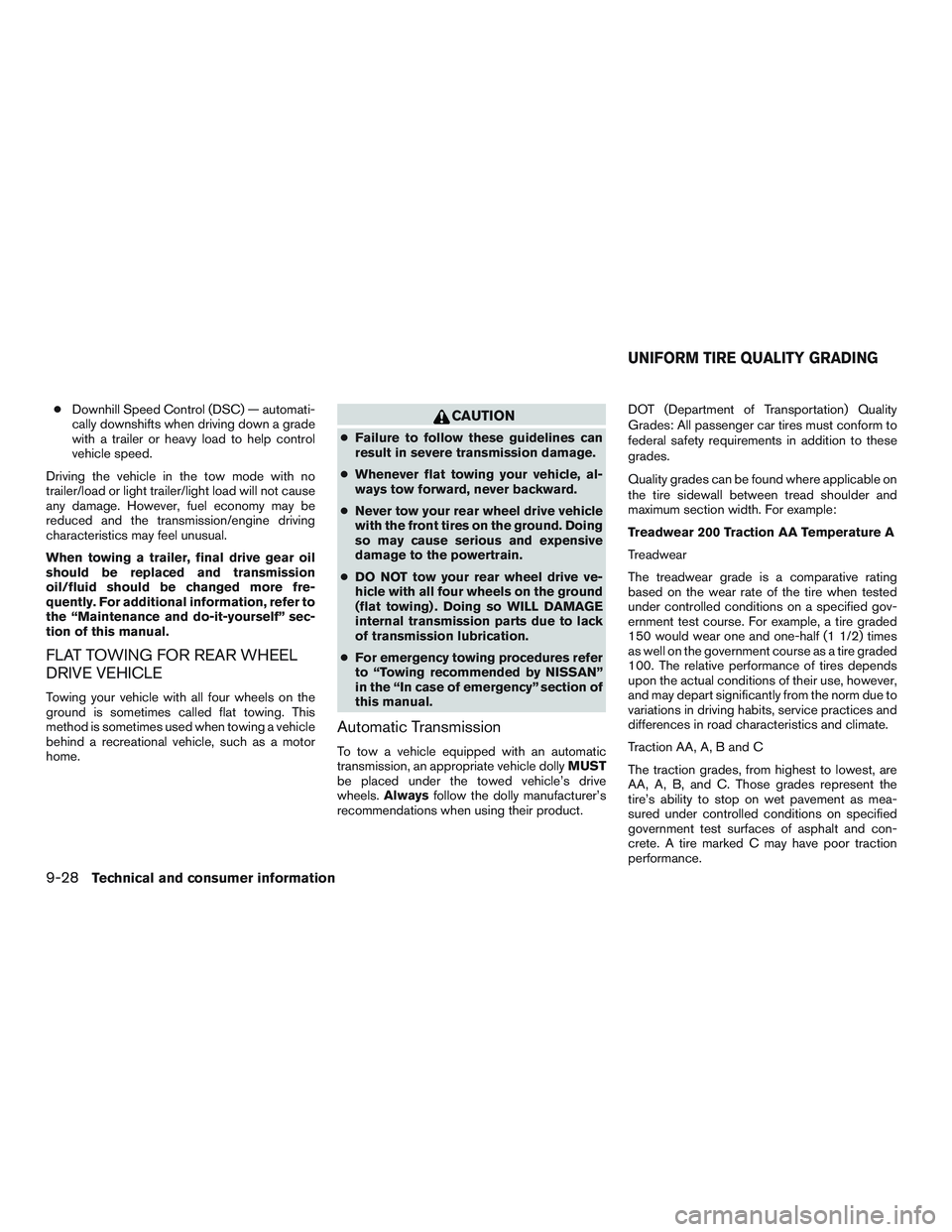
●Downhill Speed Control (DSC) — automati-
cally downshifts when driving down a grade
with a trailer or heavy load to help control
vehicle speed.
Driving the vehicle in the tow mode with no
trailer/load or light trailer/light load will not cause
any damage. However, fuel economy may be
reduced and the transmission/engine driving
characteristics may feel unusual.
When towing a trailer, final drive gear oil
should be replaced and transmission
oil/fluid should be changed more fre-
quently. For additional information, refer to
the “Maintenance and do-it-yourself” sec-
tion of this manual.
FLAT TOWING FOR REAR WHEEL
DRIVE VEHICLE
Towing your vehicle with all four wheels on the
ground is sometimes called flat towing. This
method is sometimes used when towing a vehicle
behind a recreational vehicle, such as a motor
home.
CAUTION
● Failure to follow these guidelines can
result in severe transmission damage.
● Whenever flat towing your vehicle, al-
ways tow forward, never backward.
● Never tow your rear wheel drive vehicle
with the front tires on the ground. Doing
so may cause serious and expensive
damage to the powertrain.
● DO NOT tow your rear wheel drive ve-
hicle with all four wheels on the ground
(flat towing) . Doing so WILL DAMAGE
internal transmission parts due to lack
of transmission lubrication.
● For emergency towing procedures refer
to “Towing recommended by NISSAN”
in the “In case of emergency” section of
this manual.
Automatic Transmission
To tow a vehicle equipped with an automatic
transmission, an appropriate vehicle dolly MUST
be placed under the towed vehicle’s drive
wheels. Always follow the dolly manufacturer’s
recommendations when using their product. DOT (Department of Transportation) Quality
Grades: All passenger car tires must conform to
federal safety requirements in addition to these
grades.
Quality grades can be found where applicable on
the tire sidewall between tread shoulder and
maximum section width. For example:
Treadwear 200 Traction AA Temperature A
Treadwear
The treadwear grade is a comparative rating
based on the wear rate of the tire when tested
under controlled conditions on a specified gov-
ernment test course. For example, a tire graded
150 would wear one and one-half (1 1/2) times
as well on the government course as a tire graded
100. The relative performance of tires depends
upon the actual conditions of their use, however,
and may depart significantly from the norm due to
variations in driving habits, service practices and
differences in road characteristics and climate.
Traction AA, A, B and C
The traction grades, from highest to lowest, are
AA, A, B, and C. Those grades represent the
tire’s ability to stop on wet pavement as mea-
sured under controlled conditions on specified
government test surfaces of asphalt and con-
crete. A tire marked C may have poor traction
performance.
UNIFORM TIRE QUALITY GRADING
9-28Technical and consumer information
Page 373 of 380
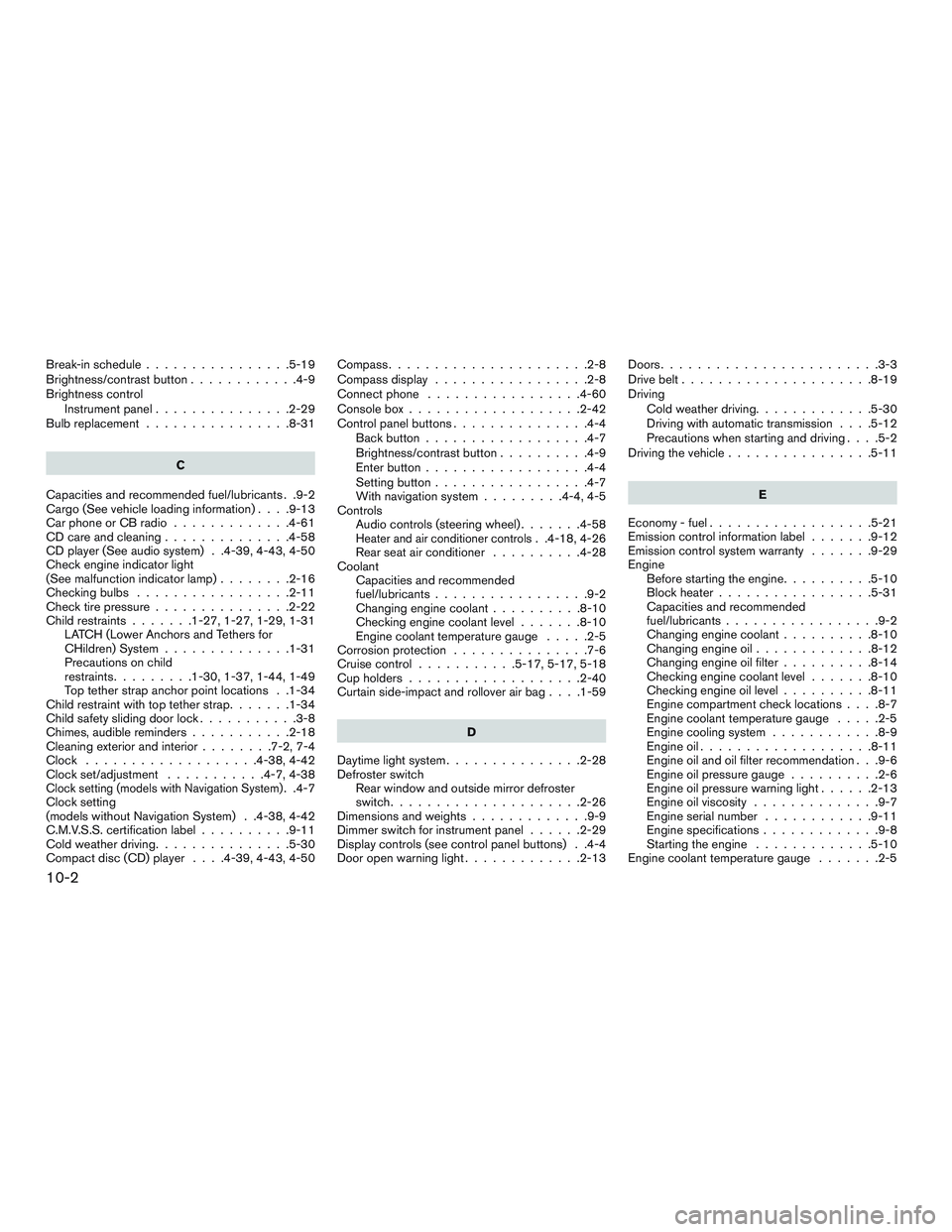
Break-in schedule................5-19
Brightness/contrastbutton............4-9
Brightness control Instrument panel ...............2-29
Bulb replacement ................8-31
C
Capacities and recommended fuel/lubricants . .9-2
Cargo(Seevehicleloadinginformation)....9-13
Car phone or CB radio .............4-61
CD care and cleaning ..............4-58
CD player (See audio system) . .4-39, 4-43, 4-50
Check engine indicator light
(Seemalfunctionindicatorlamp)........2-16
Checkingbulbs .................2-11
Check tire pressure ...............2-22
Child restraints .......1-27,1-27,1-29,1-31
LATCH (Lower Anchors and Tethers for
CHildren) System ..............1-31
Precautions on child
restraints.........1-30,1-37,1-44,1-49
Top tether strap anchor point locations . .1-34
Child restraint with top tether strap .......1-34
Child safety sliding door lock ...........3-8
Chimes, audible reminders ...........2-18
Cleaningexteriorandinterior........7-2,7-4
Clock ...................4-38,4-42
Clock set/adjustment ...........4-7,4-38
Clock setting (models with Navigation System)..4-7
Clock setting
(models without Navigation System) . .4-38, 4-42
C.M.V.S.S. certification label ..........9-11
Cold weather driving ...............5-30
Compact disc (CD) player ....4-39,4-43,4-50Compass
......................2-8
Compass display .................2-8
Connect phone .................4-60
Console box ...................2-42
Control panel buttons ...............4-4
Back button ..................4-7
Brightness/contrast button ..........4-9
Enterbutton..................4-4
Setting button .................4-7
With navigation system .........4-4,4-5
Controls Audio controls (steering wheel) .......4-58
Heater and air conditioner controls. .4-18, 4-26
Rear seat air conditioner ..........4-28
Coolant Capacities and recommended
fuel/lubricants .................9-2
Changingenginecoolant..........8-10
Checking engine coolant level .......8-10
Engine coolant temperature gauge .....2-5
Corrosion protection ...............7-6
Cruisecontrol ...........5-17,5-17,5-18
Cupholders...................2-40
Curtainside-impactandrolloverairbag....1-59
D
Daytime light system ...............2-28
Defroster switch Rear window and outside mirror defroster
switch.....................2-26
Dimensionsandweights.............9-9
Dimmer switch for instrument panel ......2-29
Display controls (see control panel buttons) . .4-4
Door open warning light .............2-13 Doors
........................3-3
Drive belt .....................8-19
Driving Cold weather driving .............5-30
Driving with automatic transmission ....5-12
Precautions when starting and driving ....5-2
Driving the vehicle ................5-11
E
Economy-fuel..................5-21
Emission control information label .......9-12
Emission control system warranty .......9-29
Engine Before starting the engine ..........5-10
Blockheater.................5-31
Capacities and recommended
fuel/lubricants.................9-2
Changing engine coolant ..........8-10
Changingengineoil.............8-12
Changing engine oil filter ..........8-14
Checking engine coolant level .......8-10
Checking engine oil level ..........8-11
Engine compartment check locations ....8-7
Engine coolant temperature gauge .....2-5
Engine cooling system ............8-9
Engineoil...................8-11
Engine oil and oil filter recommendation . . .9-6
Engineoilpressuregauge..........2-6
Engine oil pressure warning light ......2-13
Engine oil viscosity ..............9-7
Engine serial number ............9-11
Engine specifications .............9-8
Starting the engine .............5-10
Engine coolant temperature gauge .......2-5
10-2
Page 374 of 380
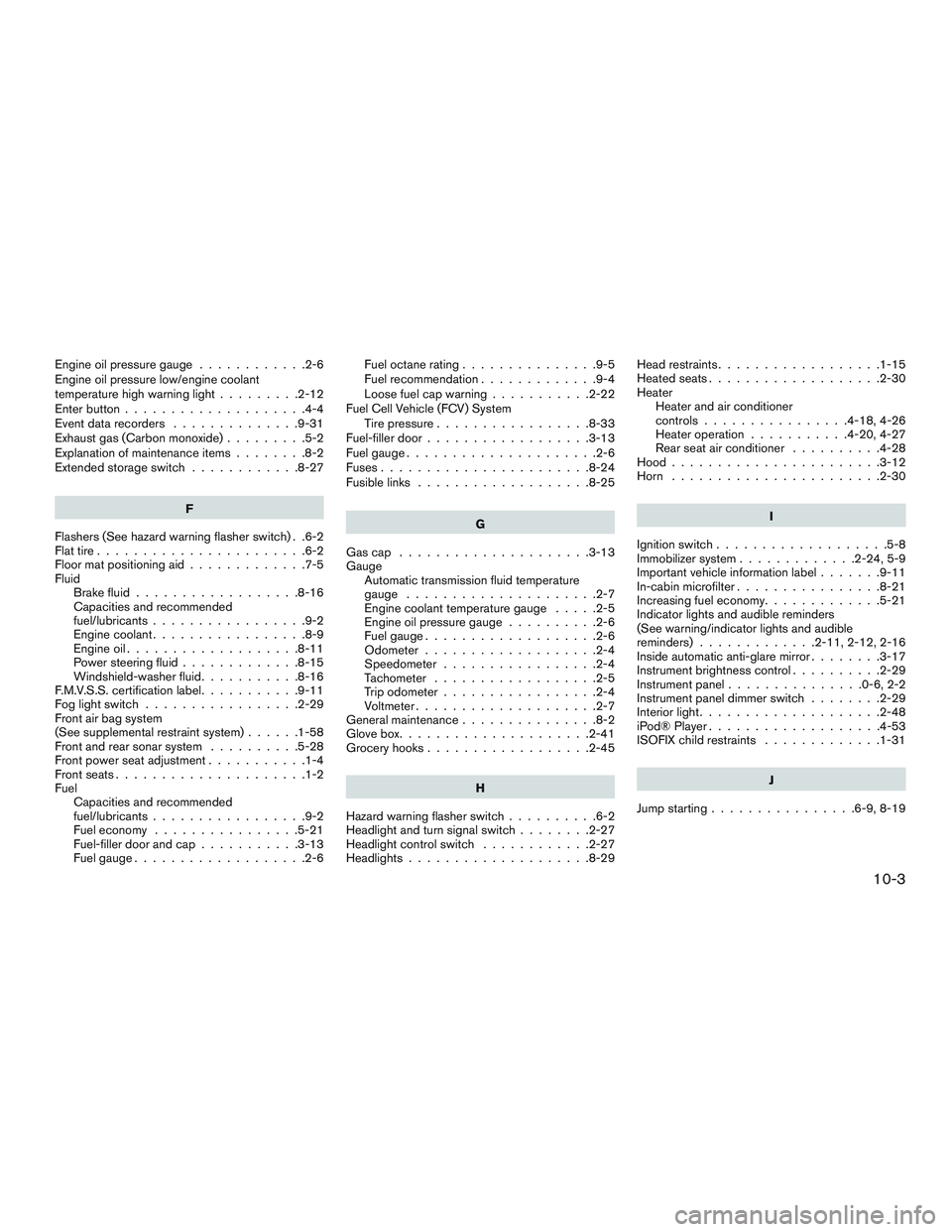
Engineoilpressuregauge............2-6
Engine oil pressure low/engine coolant
temperature high warning light.........2-12
Enterbutton....................4-4
Event data recorders ..............9-31
Exhaust gas (Carbon monoxide) .........5-2
Explanation of maintenance items ........8-2
Extendedstorageswitch ............8-27
F
Flashers (See hazard warning flasher switch) . .6-2
Flat tire .......................6-2
Floor mat positioning aid .............7-5
Fluid Brake fluid ..................8-16
Capacities and recommended
fuel/lubricants .................9-2
Engine coolant .................8-9
Engine oil ...................8-11
Power steering fluid .............8-15
Windshield-washerfluid...........8-16
F.M.V.S.S. certification label ...........9-11
Foglightswitch .................2-29
Front air bag system
(See supplemental restraint system) ......1-58
Front and rear sonar system ..........5-28
Front power seat adjustment ...........1-4
Frontseats.....................1-2
Fuel Capacities and recommended
fuel/lubricants .................9-2
Fuel economy ................5-21
Fuel-filler door and cap ...........3-13
Fuel gauge ...................2-6 Fuel octane rating
...............9-5
Fuel recommendation .............9-4
Loose fuel cap warning ...........2-22
Fuel Cell Vehicle (FCV) System Tirepressure.................8-33
Fuel-filler door ..................3-13
Fuelgauge.....................2-6
Fuses.......................8-24
Fusiblelinks ...................8-25
G
Gascap .....................3-13
Gauge Automatic transmission fluid temperature
gauge .....................2-7
Engine coolant temperature gauge .....2-5
Engine oil pressure gauge ..........2-6
Fuel gauge ...................2-6
Odometer ...................2-4
Speedometer .................2-4
Tachometer ..................2-5
Trip odometer .................2-4
Voltmeter....................2-7
General maintenance ...............8-2
Glovebox.....................2-41
Grocery hooks ..................2-45
H
Hazard warning flasher switch ..........6-2
Headlight and turn signal switch ........2-27
Headlight control switch ............2-27
Headlights ....................8-29 Head restraints
..................1-15
Heated seats ...................2-30
Heater Heater and air conditioner
controls ................4-18,4-26
Heater operation ...........4-20,4-27
Rear seat air conditioner ..........4-28
Hood.......................3-12
Horn .......................2-30
I
Ignition switch ...................5-8
Immobilizer
system .............2-24,5-9
Important vehicle information label .......9-11
In-cabin microfilter ................8-21
Increasing fuel economy .............5-21
Indicator lights and audible reminders
(See warning/indicator lights and audible
reminders).............2-11,2-12,2-16
Inside automatic anti-glare mirror ........3-17
Instrument brightness control ..........2-29
Instrumentpanel...............0-6,2-2
Instrument panel dimmer switch ........2-29
Interior light ....................2-48
iPod®Player...................4-53
ISOFIX child restraints .............1-31
J
Jump starting ................6-9,8-19
10-3
Page 375 of 380
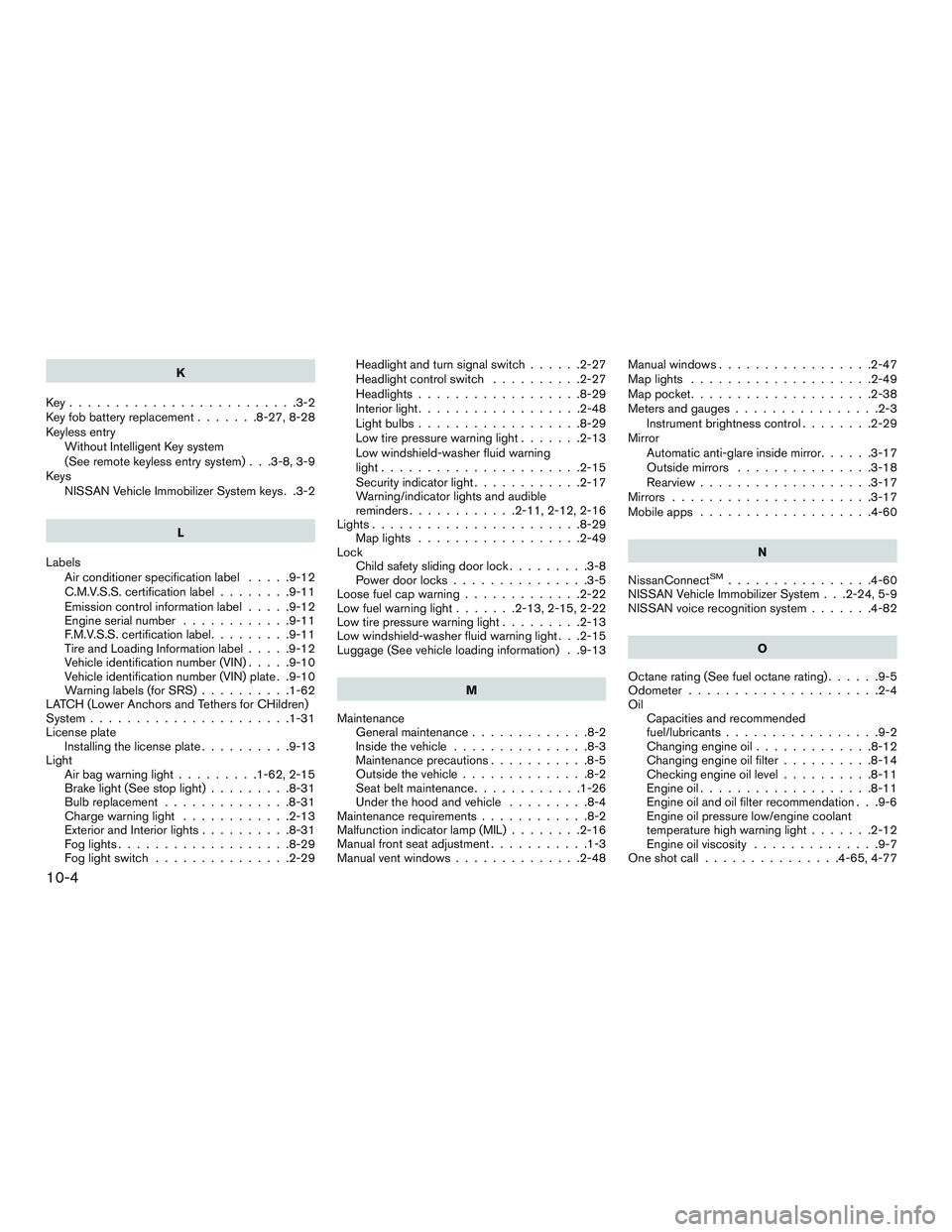
K
Key.........................3-2
Key fob battery replacement .......8-27,8-28
Keyless entry Without Intelligent Key system
(See remote keyless entry system) . . .3-8, 3-9
Keys NISSAN Vehicle Immobilizer System keys . .3-2
L
Labels Air conditioner specification label .....9-12
C.M.V.S.S. certification label ........9-11
Emissioncontrolinformationlabel.....9-12
Engine serial number ............9-11
F.M.V.S.S. certification label .........9-11
Tire and Loading Information label .....9-12
Vehicle identification number (VIN) .....9-10
Vehicle identification number (VIN) plate . .9-10
Warning labels (for SRS) ..........1-62
LATCH (Lower Anchors and Tethers for CHildren)
System ......................1-31
License plate Installing the license plate ..........9-13
Light Airbagwarninglight.........1-62,2-15
Brake light (See stop light) .........8-31
Bulb replacement ..............8-31
Charge warning light ............2-13
ExteriorandInteriorlights..........8-31
Foglights...................8-29
Foglightswitch ...............2-29 Headlight and turn signal switch
......2-27
Headlight control switch ..........2-27
Headlights..................8-29
Interiorlight..................2-48
Lightbulbs..................8-29
Low tire pressure warning light .......2-13
Low windshield-washer fluid warning
light......................2-15
Security indicator light ............2-17
Warning/indicator lights and audible
reminders ............2-11,2-12,2-16
Lights.......................8-29 Maplights ..................2-49
Lock Child safety sliding door lock .........3-8
Power door locks ...............3-5
Loose fuel cap warning .............2-22
Lowfuelwarninglight.......2-13,2-15,2-22
Low tire pressure warning light .........2-13
Low windshield-washer fluid warning light . . .2-15
Luggage (See vehicle loading information) . .9-13
M
Maintenance Generalmaintenance.............8-2
Insidethevehicle...............8-3
Maintenance precautions ...........8-5
Outside the vehicle ..............8-2
Seatbeltmaintenance............1-26
Underthehoodandvehicle .........8-4
Maintenancerequirements............8-2
Malfunction indicator lamp (MIL) ........2-16
Manual front seat adjustment ...........1-3
Manual vent windows ..............2-48 Manual windows
.................2-47
Maplights ....................2-49
Mappocket....................2-38
Meters and gauges ................2-3
Instrument brightness control ........2-29
Mirror Automatic anti-glare inside mirror ......3-17
Outside mirrors ...............3-18
Rearview ...................3-17
Mirrors ......................3-17
Mobileapps ...................4-60
N
NissanConnect
SM................4-60
NISSAN Vehicle Immobilizer System . . .2-24, 5-9
NISSAN voice recognition system .......4-82
O
Octane rating (See fuel octane rating) ......9-5
Odometer .....................2-4
Oil Capacities and recommended
fuel/lubricants.................9-2
Changingengineoil.............8-12
Changing engine oil filter ..........8-14
Checking engine oil level ..........8-11
Engineoil...................8-11
Engine oil and oil filter recommendation . . .9-6
Engine oil pressure low/engine coolant
temperature high warning light .......2-12
Engine oil viscosity ..............9-7
Oneshotcall...............4-65,4-77
10-4